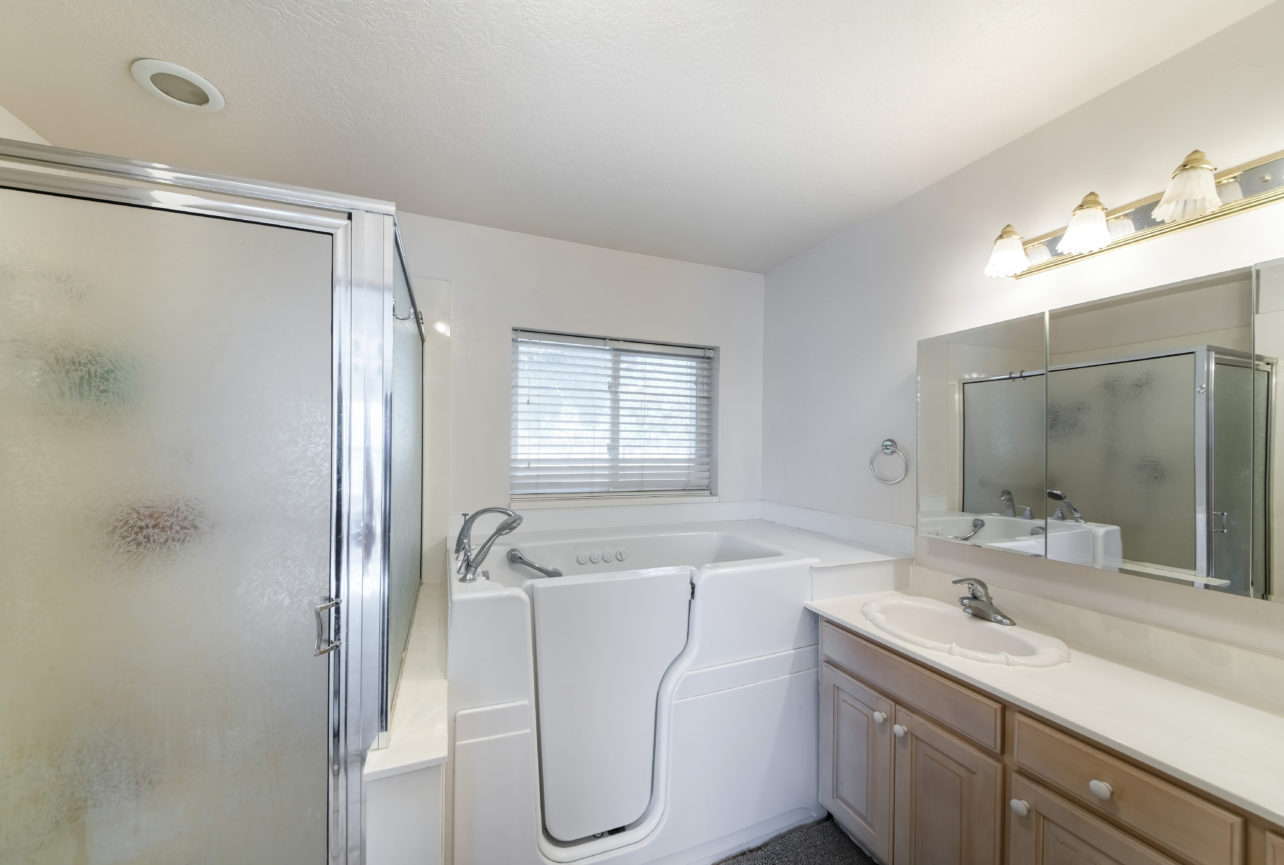What is a walk in tub?
A walk in bathtub is basically a taller bathtub with a door. They tend to be designed with standing or sitting in mind, so they are boxier and usually have seating and a handrail. They were designed for the elderly and disabled, so that they can take a bath more safely. For those with joint pain or muscular problems, it can be difficult to get over the side of the bathtub on their own, especially when it is wet and slippery, and a shower can be just as dangerous. This is where a walk in tub can be very helpful.
The door of the tub allows an elderly, injured, sick, lr disabled person to have some independence and safety while taking a bath. They are able to open the door and walk into their bathtub and sit down in it. They can then fill it up, wash, relax in the bath, and then drain it, open the door again, and walk back out.
A walk in bathtub can be nearly 4 feet tall, 3-4 times taller than a standard tub. This allows them to have features that can make the bath even more comfortable and enjoyable for the bather. Many walk in tubs have whirlpool jets and a heated seat.
Benefits of a walk in tub
There are many health benefits to soaking in a bathtub for both heat therapy and hydrotherapy. A walk in tub allows those who need the hydrotherapy of a hot bath the most to get it safely. A hot bath can help soothe sore muscles and joints, but those joint and muscle problems can be what is making it dangerous for you to take a bath in the first place. There is always a slip hazard in any bathroom, especially in the bath or shower. This can discourage those with stiff or sore muscles and joints from being able to take a bath on their own. Relying on the help of others to clean themselves. Being able to bathe safely without needing support can greatly improve quality of life, giving you some of your independence back.
There are many features installed in most walk in tubs to enhance your safety and therapeutic bathing experience while using them. Lots of walk in bathtubs are equipped with hydrotherapy jets, a heated backrest, a handshower, and a fast drain. These make the bath more therapeutic and easy to use. Some safety features include low step, handrails, and textured surfaces for a slip resistant floor and walls. A bariatric tub will come with an extra-large door to allow for larger people.
If you are considering selling your home in the future, a walk in tub can still be a good investment. Having a walk in bathtub increases the value of your home. And since they can be used by anyone, they won’t turn anyone away.
Walk in tubs are definitely more expensive than a standard bathtub. Since they have so many features and are more advanced than a typical tub, they are going to cost more to buy and to install. They do hold more water than a standard tub and will cost more each bath you take because of that.
While there can certainly be a cost downside to a walk in bathtub, if you or someone in your household struggles with age, injury, or a disability, they could greatly benefit from having one. For those who really need a walk in tub, the cost is worth it because now they can bathe safely and comfortably. This plus the added heat therapy and hydrotherapy that a walk in tub can provide can make the high price tag worth it.
Cost and installation
Depending on the type of walk in tub you are trying to buy, cost and installation will be different. The material it is made of will also affect cost. Most tubs are either fiberglss or acrylic. Cheaper tubs are often made with fiberglass that has a gel coating. The more expensive bathtubs will be made from a sturdier acrylic. Acrylic will last longer and is more durable, but that means more expensive. The type of drain and drain system you have will impact how expensive it is. The cost is also going to change depending on the size of the tub and what type of door and the quality of door seal it has.
The basic types of walk in tub costs are outlined here.
Soaking tub
A soaking tub is the most basic walk in bathtub on the market. There are no whirlpool jets or heated functions. It is like a standard bathtub except it is taller, holds more water, and has a door. These tend to be the cheapestest at around $2000, and the most expensive of these is about $6000. While soaking in a tub alone can be very beneficial, some people want more therapeutic options.
Aerotherapy tub
An aerotherapy bathtub is a step up from a soaker. It is equipped with air jets that circulate the water. Since it provides more therapy options, it costs more than a soaking bathtub. Aerotherapy tubs typically range from about $3000 to $8000.
Hydrotherapy tubs
A hydrotherapy tub is similar to an aerotherapy tub, except it’s whirlpool is stronger. Hydrotherapy has water jets instead of air jets to have less bubbles and a stronger current. These can cost less than $3000, or more than $8000 depending on quality and brand.
Bariatric tubs
A bariatric tub will be larger and sturdier than other walk in tubs. They can have all the same features as a normally sized walk in tub; they are just bigger and stronger. A bariatric tub will have an extra wide door. These are usually $4000 to $5500, depending on brand and features.
Wheelchair accessible
These tubs will also be much bigger in order to accommodate a wheelchair. For these bathtubs, you can just wheel a shower chair or a wheelchair right in and fill it up so you dont have to transfer from a wheelchair to a seat or bench in the tub. This allows independence for those who are wheelchair-bound because they won’t need help in and out of a wheelchair in order to bathe. The price of wheelchair accessible tubs can vary depending on what kind of therapies are available with it.
Two-seater bathtub
A two seater bathtub is usually the most expensive. These are going to provide the most spa-like experience. They are big enough to seat at least 2 people and usually have jet therapies and heat therapies installed as well. These can range from $5000 to as much as $20000.
Shower and bath combo
A shower and bath combo is just a walk in bathtub with even higher walls to provide a sturdier, enclosed environment to shower in. These can be between $3000 and $4600. You can also get a detachable shower enclosure that you can add on when you need it for a less expensive option.
Other factors in cost
Does medicare cover a walk in tub?
As a general rule, medicare will not cover the costs of a walk in tub. Since walk in tubs require such complicated installation anc changes to your home, it is not just considered as a piece of equipment used to treat a medical issue. Insurance is complicated, and with the right wording from a doctor’s prescription and the right plan with the right insurance company could get you reimbursment, so there is no harm in asking around about coverage, but the general rule is that no, insurance does not cover a walk in tub.
Installation factors and cost
Depending on the kind of tub you buy and where you want to place it, installation can cost between $2000 and $10000, depending on the tub manufacturer and the installation company. There are a couple of other factors that can play into the cost:
Drain problems
Your plumbing can add to the cost of installation. Most walk in tubs feature a fast working drain, but if you have tight, clogged, or old pipes, they might not support the drain for your tub. You might have to update or at least clear out your pipe system before you can properly install the bathtub so that the water can drain the right way.
Water heaters
Some walk in bathtubs can hold more water than a typical water heater. So, if you want to be able to actually use your tub, you might have to get a tankless heater to accommodate the tubs capacity.
Floor plan
You might have to redo your flooring to accommodate the placement of the tub, and you might have to widen the bathroom door in order to get the tub in. If you have a drain problem you might need to rip your floors to fix that too.
Features to look for
Walk in tubs will have pros and cons, but some features to be on the look out for are:
- Jets (aerotherapy or hydrotherapy)
- Heated seat and heated backrest
- Low steps for easy access
- Watertight door (preferably swinging outward)
- Handrail
- Textureed surfaces
- Quick drain
- Accessible faucet
Best walk in tubs
Some of the best walk in tubs are listed below:
Kohler tub
Kohler is a well established brand that produces quality bathtubs. Their walk in tubs feature a 3 in step, one of the lowest on the market. Other features include a handshower faucet, a wide door with a handrail and a watertight seal, hydrotherapy jets, a heated backrest, a control panel, a gooseneck shower arm faucet to allow showering while standing, and a bathsreen to prevent splashing.
American standard is another brand that produces quality walk in bathtubs. Their tubs feature an outward swinging, watertight door, to allow for easier entering and exiting. They have a full tub seat with easy access through the wide door and low threshold. It has a textured surface and handrails to prevent slipping. They have several therapy options, including deep soak, aromatherapy, 7-color chromatherapy, and hydrotherapy jets.
Leaf Home safety solutions tub
Leaf home safety solutions is another great option for a walk in bathtub. They feature hydrojets and heat panels with a control panel.
Conclusion
Many elderly, injured, and disabled people can benefit greatly from a walk in tub. It gives more independence to those who otherwise cannot safely bathe themselves. In Home Care is a great site to look for options of medical care that can be taken home. Having a walk in bathtub can make the bathroom a much safer place for those with joint pain and muscle problems.




